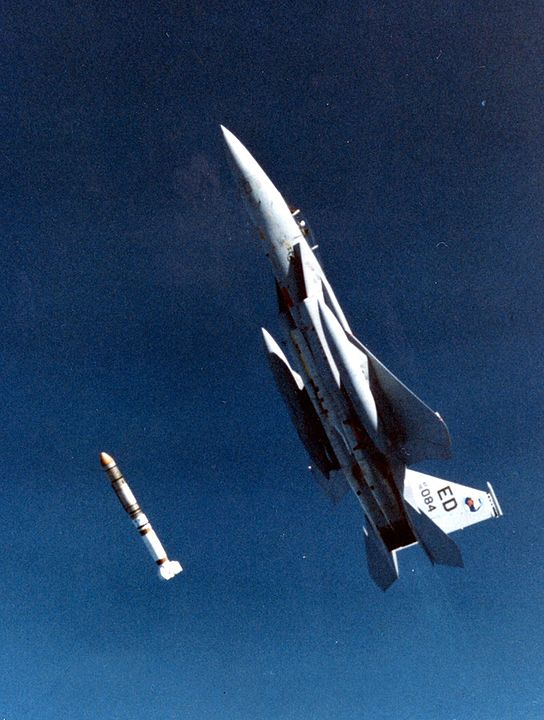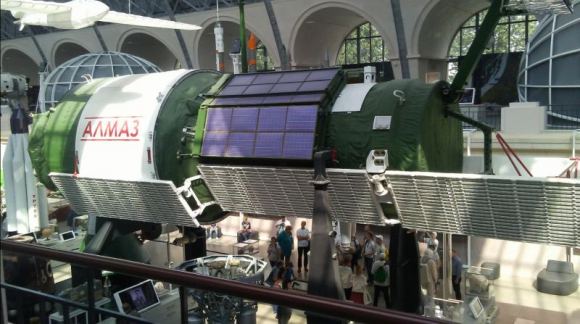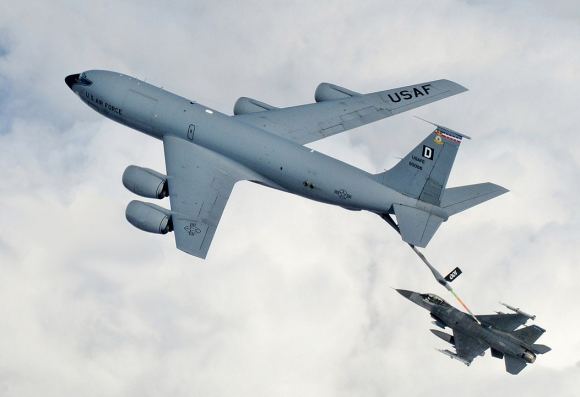
Sci-fi films about space have a very weak educational component. In the films, tough pilots, during duels, lead their spaceships through space as if they were in the atmosphere. They change the roll, make turns, loops and barrels, sometimes they use the Immelman coup - as if they depend on the gravity of the Earth. Is it realistic?
No.
In fact, combat in space is likely to look completely different. And since more and more equipment is entering space, and conflicts in the future are quite possible, it's time to think: what will a battle in space actually look like?
The not-for-profit Aerospace Corporation has decided that now is the time to consider this issue. Dr. Rebecca Reesman of the Center for Space Policy and Strategy at the Aerospace Corporation has collaborated with colleague James Wilson to write a research paper on space warfare. It's called "The Physics of Space War: How Orbital Dynamics Limit Combat in Space ."
If the future of people can be judged by the past, then the militarization of space will continue. Despite all the talks and agreements about the need for peaceful outer space. As more countries are entering space, and competition for resources begins to cause problems, it is time to give realism to the reasoning about space conflicts.
This is what the authors try to say in the introduction to their work. “The US and the rest of the world are discussing the possibility of continuing conflicts into space. It is important to gain a general understanding of what will be physically possible and practical in this area. Episodes from "Star Wars", books and TV series paint a completely different world than we will be able to see in the next 50 years, and maybe in principle - and all because of the laws of physics. "
There have been no battles in space yet, but weapons are already being tested. China is working on an anti-satellite weapon, and has tested one such missile. So does India. Russia is also working on similar weapons, and the United States. Back in 1985, the United States managed to destroy one of its satellites with a rocket.

Airplane F-15A Eaglelaunched an ASM-135 rocket during tests in 1985, which destroyed the Solwind P78-1 satellite.
And this is probably only the tip of the iceberg associated with future conflicts in space. So far, none of these tests have involved humans inside the spacecraft. The paper says it may never be necessary. "Space battles in the modern world will be conducted exclusively by unmanned vehicles, which will be controlled by ground operators, and will also experience limitations associated with the physics of motion in space."
In the early days of the space age, at the height of the Cold War, the superpowers envisioned that conflicts in space would be largely an extension of conflicts on Earth. The USSR even designed space stationswith a modified HP-23 automatic cannon on board to repel the attacks of American astronauts. The United States has worked in a similar vein.

Soviet inhabited space station "Almaz" in the pavilion "Cosmos" at the Exhibition of Economic Achievements in Moscow. Various military satellites and space stations were designed in Russia, some of which were planned to be armed with automatic weapons. The idea was later discarded as too expensive.
However, technological progress has made it possible to abandon these projects in favor of unmanned satellites. “As a result, both programs were curtailed. Instead, improvements in technology and data transmission systems have allowed the creation of satellites capable of performing military functions that were previously planned to be placed on the shoulders of astronauts. The same progress is at the heart of our modern life with an all-pervading connection. " Now satellites dominate space, and people live only on the ISS.
This future is described in the article. In the next 50 years, space conflicts will be associated with attacks on satellites. But not all of these attacks will be direct and explicit. The authors describe four targets for the space attack:
- To deceive the enemy into acting to his own detriment.
- Disrupt or seriously impair the enemy's ability to use space equipment, temporarily or permanently.
- Completely destroy the space capabilities of the enemy.
- Defend against counterattacks, both in space and on Earth.
The satellites move predictably. They move quickly, but their future location is easy to predict and therefore easy to intercept in many cases. Some satellites can change the altitude of the orbit, but they have no real maneuverability, as well as a way to evade an attack.
“To describe the fundamentals of physics limiting space attacks, this paper outlines five key concepts: satellites move quickly and predictably and maneuver slowly; space is large; it is very important to choose the right moment. "
Flying through the Earth's atmosphere is not easy, but intuitive. However, everything is different in space, and this, strictly speaking, is not even flight. In the absence of atmosphere and gravity, everything changes. “Traveling in space will be counter-intuitive for those who are accustomed to flying in the Earth's atmosphere and have a chance to refuel,” the authors write.

Space battles will be fought between satellites, and you won't be able to refuel. Photo: F-16 refueled by KC-135 Stratotanker
“Space collisions will be carefully planned and slowly unfold. Space is large, and it is difficult for a spacecraft to get out of a predictable path. In addition, attacks in space will require great precision, since spacecraft and ground weapons will only be able to attack a target in space after complex calculations. ” There will be no operational personnel of pilots ready to blow up and take off quickly. The space battle of satellites will be more like a math exercise.
“Physics imposes its own limits on what happens in space. Only by mastering them, you can solve other issues - how to fight, and, more importantly, when and why to wage war in space, ”they write.
The orbit of a satellite is easy to predict because speed, altitude, and shape are all related. At low altitudes, satellites are braked by the atmosphere. Moreover, the Earth is not a perfect ball. However, all these factors can be taken into account during an attack. “To deviate from the established orbit, satellites need to use the engine to maneuver. This distinguishes them from airplanes that use air for maneuvers - this option will not work in the vacuum of space, ”they write.
| Height | Speed | Period | |
|---|---|---|---|
| Low earth orbit | 160-2000 km | 7-8 km / s | 1.5-2 h |
| Middle Earth Orbit | 2000 - 35,000 km | 3-7 km / s | 2-23.5 h |
| Geosynchronous orbit | 35 786 km | 3 km / s | 24 h |
| High elliptical orbit | Variable | 1.5-10 km / s | 12-24 h |
In a space battle, even the volume of space itself must be taken into account. “There is about 200 trillion cubic kilometers of space between low-earth orbit and geostationary orbit. This is 190 times the volume of the Earth. "
Therefore, tracking satellites in such a volume of space will be challenging, especially since some of them are specially designed to be difficult to detect. Difficult, but not impossible - satellites are found regularly. And since they are not very maneuverable, once the satellite's orbit is determined, its trajectory is easy to follow.
The sheer volume of space also means that most space battles will be very short-lived. No duels are expected. “Space is great, so space battles will not last long and actively. Either it will be a short and strong change in the speed of the apparatus to achieve a quick effect, or a long and gradual change for a small or constant interaction. "
Changing speed requires fuel, but most satellites do not have the ability to change speed, while others have very limited options.
“It may take several weeks for the operators of the attacking satellite to move it to the desired position. During this time, the conditions due to which it was necessary to conduct the attack, or the object of the attack itself, may change. " And if the defending satellite can only slightly change its trajectory in response, then the attacker may not have enough capacity or fuel to properly adjust its path for interception.
The authors also point out the extreme importance of choosing the right timing. Even if the attacking satellite can enter the target's orbit, there is no guarantee that it will be able to get close enough to it.
"The nature of the conflict often requires that two competing weapons systems move closer together," the report says. The authors use examples with an aircraft carrier, which needs to approach the target, and with jet fighters, which need to approach. The same is true for satellites.
“It is quite easy to bring two satellites to the same altitude in the same plane (although it takes time and speed adjustments). But this does not mean that they will end up in the same place. It is also necessary to coincide in phase - a point on the orbital trajectory. Since altitude and speed are related, the task of bringing two satellites to one place is not intuitive. " This requires precise timing and careful preparation.

Satellites change their location in orbit using phase maneuvers. As the altitude increases, the satellite slows down and, as it were, moves backward relative to the previous orbit and altitude. So one satellite can catch up with another.
The authors also discuss another method of convergence with a target - plane coincidence. The satellite maneuvers so as to align its orbital plane with the target plane. As a result, the attacker has an advantage in setting the meeting time. "Without making threatening maneuvers too early, the attacker can appear harmless while waiting for the optimal moment to attack," the authors explain.
All of these maneuvers do not go quickly. “Space physics dictates slow attacks in space. The satellites need to maneuver for several days, if not weeks or months, to get into a position in which they can do something, ”they write. But you can do it.
And when everything is ready for interception, "there are many opportunities for a quick approach to the target."
There are natural limitations on the maneuvering of satellites in low Earth orbit. On the one hand, some phase maneuvers can send a satellite into the atmosphere, where it burns up. On the other hand, it may go too far away from low Earth orbit, into the Earth's radiation belt . Therefore, the satellite's maneuverability is limited.

If the satellite performs a direct phase maneuver, changing the speed by 115 m / s, it will return to the Earth's atmosphere and burn up. If he performs a reverse phase maneuver, changing the speed by 350 m / s, he will fall into a zone of high radiation.
Satellites in geostationary orbits do not change their position relative to the Earth, so in this case the attack and defense mechanics will be different. But in general, restrictions remain. Maneuvering in space takes time and energy, regardless of the type of orbit.
However, orbits and maneuverability are not all that is covered in the article.
The authors discuss the types of possible attacks. The article describes collisions, projectiles, electronic interference. Each type requires its own considerations and training.
The authors also discuss the consequences of successful attacks - difficulties arise with the appearance of debris. They can damage other random satellites, in particular, the attacker's own satellites, or those belonging to the neutral side. There have been three successful attacks on satellites: one by China, one by the United States and one by India. The authors show graphs of the fragments from each of them.

Comparison of the density of fragments at different heights as a function of time after destruction of the target. Chinese tests took place at a much higher altitude (856 km), which is why the fragments lasted longer.
The debris cloud immediately after the attack turns out to be dense and quickly spreads in space. Although its density drops rapidly, the debris travels far away and is still dangerous.

A cloud of debris after Indian trials in 2019 - 5, 45, 90 minutes after the attack, and also after 1, 2, 3 and 6 days.
The article clearly indicates all the difficulties that arise during space battles, and their serious differences from air ones. However, some important questions remained behind the scenes.
What happens if a country decides that an attack is being prepared on its satellites? She will not sit idly by, but instead move on to accusations, threats, and possibly retaliation on Earth. A space attack could be the starting point for another ground war.
As a result, a space arms race could begin, with countries competing in spending on space weapons and other technologies. This will seriously strain the resources of the world, which needs to focus on solving the problem of climate change.
How will it end? War in orbit? The War on the Moon? A war on Mars? When will humanity come to its senses and stop?
Perhaps someday there will be a final war, after which all this will end. But this is unlikely to happen in the next 50 years. And if there is a war at this time, it is possible that the satellites will participate in it, and their battles will look as the authors described: slowly, prudently and carefully.